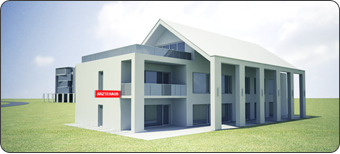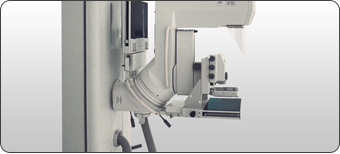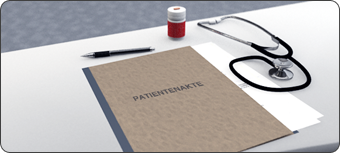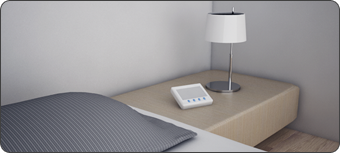

Smart Health means that innovative technology is being used to constantly improve processes and procedures in health care through the use of modern methods of diagnosis and therapy. This, however, requires a networked infrastructure for the exchange of information. Individual treatment procedures must no longer be performed in an isolated manner. Instead, all necessary measures will be organized into an integrated process. Innovative technology ensures that there are no delays and no piece of information is being lost.
Not only will money be saved through quick diagnosis, selection of proper treatment and avoiding duplicate examinations. Patients will also benefit when less burdensome interventions are available, when specialists contribute to the diagnosis, or unnecessary trips to the doctor’s office will be avoided through the use of telemedicine
Smart health offers many advantages.
Smart Health also means that the patient's personal information will be stored and exchanged. This information must be protected as far as possible. Secure technology to do so is already available. State of the art technology is used to protect information against unauthorized access or loss. Information protection is very often better than before.
As with written records, total protection is not possible, however the low risk of electronically stored information being lost or abused must be compared to its benefits. Information about one’s medical history can be life-saving in the case of an emergency. Telemedicine programs can keep health conditions stable and significantly increase the quality of life.
Because people are living longer and chronic illnesses are on the rise, medical specialists in various areas must work together. An example of this is the care of diabetic patients. In Germany, over six million people already suffer from adult diabetes (Diabetes Type II). Sustainable health management is particularly important for these patients as this is the only way to avoid complications, such as heart disease or circulatory problems in the legs.
Primary care doctors and specialists must exchange findings and treatment methods for the patient. This can be done for example, through a unified, comprehensive electronic health record. For frequently occurring diseases such as diabetes, it also makes sense that certain processes are agreed upon, so no information is lost and procedures are not doubled. One speaks of structured treatment models or "Disease Management Programs". Patients benefit from shorter waiting times, quick diagnosis and effective therapies.
Physician networks not only make treatment more efficient. They also improve the general health care as participating physicians share experiences and learn about new diagnostic and treatment options from one another. Modern technology makes it much easier than ever before to build flexible and task oriented physician networks.

The primary care physician is the central contact for many patients with diabetes. He monitors the general state of health, monitors complications, contacts specialized colleagues when needed, or organizes specific examinations or treatments. The network allows quicker planning and better preparation for appointments. What information is important? How quickly can the reply of a specialist be available? Is the chosen treatment still correct? Are there any relevant preliminary examinations by other doctors in the network? All these questions can be quickly clarified in the network. A common electronic record of the patient and the previously outlined treatment procedures ensure that the treatment is perfectly organized.

The medical specialist in the network can focus on applying his expertise. He must no longer make the general preliminary examinations. Knowing that a patient is diabetic, he can concentrate on diagnosis and treatment proposals. All relevant preliminary information is available to him for each patient. All appointments can be scheduled to assure enough time for thorough examinations. Patients do not receive needless additional appointments. Through cooperation in the network it is assured that treatment is delivered as agreed.

A physician network can also be structured to cooperate with a hospital: whether patients need a special examination or treatment in the hospital or for those who are discharged from the hospital and require further outpatient care. Diabetics in particular may need a change in their ongoing treatment after being released from the hospital following an additional condition such as a heart attack. In such a case the doctors in the network need to know which procedures were followed in the hospital and the state of health of the patient.

Diabetics and other chronically ill patients have many advantages when cared for in a physician network. The network clearly regulates when the patient should appear before which physician for check-ups. It is clearly outlined which doctor is responsible for which tasks. Questions or examinations are not duplicated because of collaboration in the network. The patient saves time and can rest assured that the participating doctors have all agreed upon the treatment. Eventually much information can be gathered comfortably at home, recorded and communicated to the physician network through remote patient monitoring. Diabetics can easily send the results of blood sugar measurements via computer or mobile phone.
For many diseases affecting a large number of people there are effective methods to detect as early as possible if the disease has already appeared. These methods channel risk groups into participating in regular screenings and evaluations by experts. An example is mammography screening in Germany, which addresses every woman over 50.
These examinations aim to discover breast cancer early enough so it can be successfully treated. The earlier breast cancer is discovered, the higher the chances for successful treatment. Each mammogram is examined by two physicians, one of whom is an expert in a screening center. The doctor conducting the examination electronically sends the X-ray to the screening center, and electronically receives the expert’s findings in return.

At the invitation by the health insurance company the patient makes an appointment for a mammogram with a specialist who takes part in the screening program. The specialist prepares his findings. He then sends the mammogram along with his findings to the screening center in his region. There, the mammogram is assessed a second time. The resulting findings are then submitted to the specialist who informs the patient about the results. Though it takes a few days until the results are available due to the second assessment, they are especially reliable and informative. This is of particular importance in cases relating to breast cancer.

The screening center plays a central role in the effectiveness of screening. All participating physicians send their mammograms and findings electronically to the center. There, all mammograms are assessed a second time by highly qualified experts. Should there be differences in the assessments, the case will be thoroughly discussed to find a conclusive diagnosis. The final results are then once more electronically delivered to the specialist. Through this process all the participating physicians can learn from one another which will contribute to achieving a correct diagnosis in difficult cases.

All women in the designated age group will be invited every two years by their health insurance companies to undergo a precautionary mammography screening with an X-ray of the breast. The risk associated with additional radiation is offset by the positive effect that breast cancer can be detected in a timely manner. In addition, special mammography equipment utilizing reduced radiation will be used for the screening.
With a stroke – an “infarct in the brain", it is necessary as quickly as possible to clarify if a stroke has actually occurred and which measures need to be taken. How serious is the stroke? Must the patient be transferred immediately to a specialized clinic? Does the condition of the patient even allow transfer?
If a stroke is quickly recognized and the right measures are taken at the hospital, then the chances of serious impairment are reduced in many cases. It is therefore important with the help of a computer tomography (CT) or an MRI scanner that a picture of the brain is made and evaluated by an expert. As appropriate experts are not available at every hospital, telemedicine can widely deliver the specialized knowledge. The CT or MRI scan is therefore electronically transmitted to another hospital, where experts diagnose the scans and inform the attending local physician of their findings.

The hospital is informed in advance by the ambulance services if a patient with a suspected stroke is being delivered. The CT unit is prepared for the necessary examination, so that it can take place immediately. The scan will be sent electronically to a specialist in the stroke network who will stay involved in the diagnosis and therapy decisions. This also includes the decision whether the patient can be treated locally or must be sent to a specialized clinic by helicopter, for example.

At the network’s center, specialists are available around the clock who can decide on the next steps based on the transmitted CT images. They send the necessary information and recommendations back to the local physician. If necessary, transport to a different clinic is scheduled. This can be done immediately or following the initial treatment.

Fast transport of the patient to the hospital is of extreme importance. The hospital must also be able to treat strokes. Where there is a “stroke network”, the ambulance can drive to the nearest hospital equipped with a CT unit. The patient comes quickly to an appropriate hospital. Long trips to specialized hospitals are no longer necessary. The treatment can begin as soon as possible.

Time is of essence with a stroke. The sooner a stroke is recognized, the better the chances that permanent harm is avoided. When signs of a stroke appear, an emergency physician must be alerted as soon as possible and informed that it could be a stroke. In some regions, there are already ambulances specially equipped for this emergency.
Remote patient monitoring – or telemonitoring -– allows monitoring of a patient suffering from a chronic disease at home. The patients do not need to travel as often to their primary care doctor for routine check-ups. Through constant observation at home, critical situations and emergencies can be avoided as there is early detection of any deterioration in health. The supervising doctors can intervene with advice and measures, before an emergency occurs.
Remote patient monitoring solutions exist for various diseases, such as diabetes, heart failure, or chronic respiratory diseases. In all cases it is necessary that the patient himself collects the necessary health information at home for which he employs easy-to-use monitoring devices. The information is forwarded to a telemonitoring center. All measures are then coordinated from there.

Even with remote monitoring, the patient regularly visits his general practitioner for a thorough examination. The primary care doctor is supplied by the telemonitoring center with all relevant data and information since the last visit. Because the patient has been recording information daily at home the physician has a much better picture of the patient’s health. He and the patient can then agree on the most appropriate therapy.

The telemonitoring center is often located at a major hospital that has the appropriate specialized unit. This assures that qualified staff is available round-the-clock, which can monitor and evaluate the patient's data. The experts have a complete picture of the health of the patient as there is a large amount of available daily information, therefore changes will be quickly noticed. Decision on next steps will then be made with the primary care doctor. The experts can also quickly react in case of an emergency and initiate the appropriate measures – including notification of an emergency physician.

Depending on the type of disease easy-to-use instruments are available to patients. With these, the patient regularly collects the relevant data. He then has a daily, firsthand view of his own health status.
The data is then transmitted to a telemonitoring center for evaluation. The center is often located at a specialized hospital. The experts there assess the state of health based on the daily incoming data. The patient then receives notice of any alterations in routine or medication due to changes in the situation.

It is important to have the medical history of patients who are delivered to the hospital as a result of an emergency. Information from the last few days plays a particularly important role as well as information about the prescribed medications or allergies. This information helps to make quick, informed decisions for the treatment of patients. In the case of telemonitoring, the center can provide this information to the hospital where the patient is being treated.

In the telemonitoring center, all incoming data is immediately investigated and compared with existing information. In case of sudden changes, the patient will be contacted and receive specific instructions on what to do. This could amount to simple instructions like taking a particular medicine, or the advice to immediately contact the general practitioner. The center can alert the doctor as well in case of an emergency. Important information from the medical history is then forwarded to the hospital while the patient is underway.

If necessary, the telemonitoring center can directly alert emergency services. The center can provide the emergency physician with additional important information while underway to the patient. Which medications does the patient take? Does he have allergies? How was his condition over the last few days? This information helps the emergency physician to quickly make correct decisions on site.

The 24/7 telemonitoring center will notice if measurements of the patient’s data deteriorate suddenly and dangerously. The patient then receives a phone call or is contacted via video link. In this way, the patient receives instructions on how to react and whether the center will alert an ambulance.
This emergency service gives patients a great deal of additional security in everyday life and raises the quality of life.